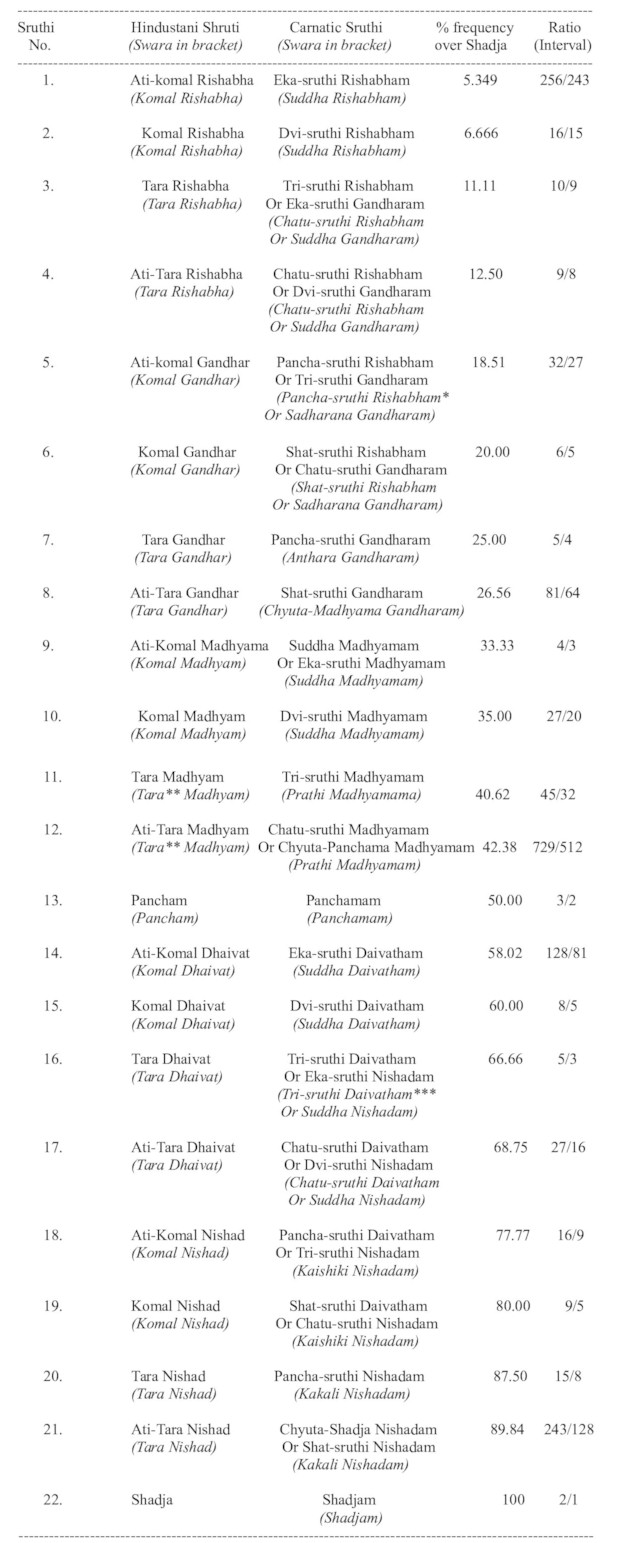In reality, the 22 shrutis are 'same'—as the human ear is the 'same' all over the world, the perception of 12 universal notes (12 Swaras) changing at 22 points (22 shrutis) on any string, also remain the same. (See 'Play the shrutis yourself' section on Homepage)
However, the names of Swaras and Shrutis are different in the Hindustani and Carnatic systems. They are given in the following table, along with the names of Swaras in respective systems in bracket.

* Shat-sruthi Rishabham as a swara can not have Pancha-sruthi Rishabham as a sruthi ! Hence, this Swara should be called as 'Pancha-sruthi Rishabham or Sadharana Gandharam' only.
** This is wrongly termed as 'Teevra Madhyam'. The dictionary meaning of Teevra is that which denotes the 'loudness' or 'volume' of sound, not frequency. Tara is the correct word, meaning 'frequency' of sound. This Madhyam is of a higher 'frequency', not of a higher 'loudness', and hence should be called as 'Tara', and not 'Teevra' !
*** Chatu-sruthi Daivatham as a swara can not have Tri-sruthi Daivatham as a sruthi ! Hence, this Swara should be called as 'Tri-sruthi Daivatham or Suddha Nishadam' only.
Ratios are important to a musician – because they indicate the exact 'position' where the shruti can be played on 'any' string. e.g, 15/8 for Tara Nishad or Kakali Nishadam means that if the string was divided in 15 parts, the shruti can be played on the 8th part (8/15 = 53.33% length of the string). Similarly, 243/128 indicates that if the string was divided in 243 parts, the shruti can be played on the 128th part (128/243 = 52.67 % length of the string).
Sruthis of Gandhar and Nishad - Some experts believe that similar to Rishabha and Daivatha, there 6 sruthis of Gandhar and Nishad each, in Carnatic system. These are not different sruthis, but indicate just the 'naming' of sruthis. e.g., R3=G1, R4=G2, D5=N3, D6=N4 and so on, as follows.

Gamakams - in Carnatic Music is the basic process of Music creation in which the 'Sruthis' are connected by 'Nadas' in between. Here, a 'stay' is made on Sruthis (for > 20 msec, the time required by the human ear to identify a musical note), and the 'connecting' Nadas are taken faster/quicker (for < 20 msec so that the human ear can 'hear' the Nada, but can not identify the Swara !).
The process of creating music in the Hindustani system is also exactly the same. The difference in the 2 systems is only in terms of the 'way' in which the 'connecting' Nadas are used. Basic 12 Swaras and 22 Shrutis remain the same.
12 Swaras have 16 Names - in Carnatic system. This is so because of the essential rule that in Sampoorna Ragas (with all 7 notes), the notes should be pronounced in a sequence ONLY, as Sa, Ri, Ga, Ma, Pa, Da, Ni. Hence, e.g.,
- 1When Suddha and Chatusruthi Rishabha, BOTH are used in a Raga, Chatusruthi Rishabha must be pronounced as 'Ga' (because it comes 'after' Suddha Ri). This Chatusruthi Rishabham gets a 'different' name which is Suddha Gandharam, 'Suddha' meaning the '1st' of the 3 Gandharams as Swaras. Such a note with a different pronunciation is called as 'Vikruta' swara in Carnatic system. This Suddha Gandharam as a Swara can have 2 Sruthis/frequencies (positions on the string) , namely Tri-sruthi and Chatu-sruthi Rishabham as shown in the above table.
- 2When Suddha and Chatusruthi Daivatham, BOTH are used in a Raga, Chatusruthi Daivatham must be pronounced as 'Ni' (because it comes 'after' Suddha Da). This Chatusruthi Daivatham gets a 'different' name which is Suddha Nishadam, 'Suddha' meaning the '1st' of the 3 Nishadams as Swaras. Such a note with a different pronunciation is called as 'Vikruta' swara in Carnatic system. This Chatusruthi Daivatham as a Swara can have 2 Sruthis/frequencies (positions on the string) , namely Tri-sruthi and Chatu-sruthi Daivatham as shown in the above table.
- 3When Sadharana and Anthara Gandharams, BOTH are used in a Raga, Sadharana Gandharam must be pronounced as 'Ri' (because it comes 'before' Anthara Ga). This Sadharana Gandharam gets a 'different' name which is Shatsruthi Rishabham. Such a note with a different pronunciation is called as 'Vikruta' swara in Carnatic system. This Sadharana Gandharam as a Swara can have 2 Sruthis/frequencies (positions on the string) , namely Pancha-sruthi and Shat-sruthi Rishabham as shown in the above table.
- 4When Kaishiki and Kakali Nishadams, BOTH are used in a Raga, Kaishiki Nishadam must be pronounced as 'Dha' (because it comes 'before' Kakali Ni). This Kaishiki Nishadam gets a 'different' name which is Shatsruthi Daivatham. Such a note with a different pronunciation is called as 'Vikruta' swara in Carnatic system. This Shatsruthi Daivatham as a Swara can have 2 Sruthis/frequencies (positions on the string) , namely Pancha-sruthi and Shat-sruthi Daivatham as shown in the above table.
Thus, in the above 4 situations, 4 swaras are named 'differently' in Carnatic system to indicate a 'Vikruta' swara (with a different pronunciation). Hence, 12 swaras have 16 names in Carnatic system.
72 Thataas - are used in Carnatic system and this is a neater and well-structured system than the arbitrary 10-Thaata Hindustani system. Hindustani system will have to graduate to the systematic Carnatic Thaata system in future, to get rid of the current mismatching of Ragas and Thaats.

